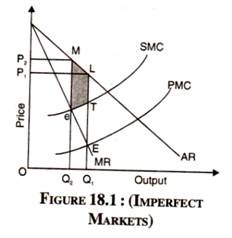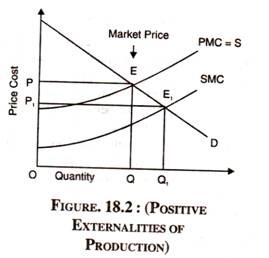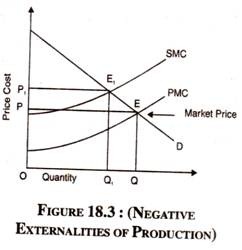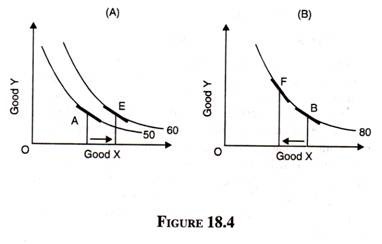Some of the main incidence of taxation are as follows:
Meaning of Incidence:
It is important to study who ultimately bears the burden of a tax. The incidence of taxation refers to this question of who and in what proportion bears the final burden of a tax. It is not necessary that a person or a firm who pays a tax to the Government or, in other words, bears the initial burden of a tax will also be one on whom the final burden of the tax rests.
This is because a tax can be shifted or transferred to others. Therefore, in economics, we distinguish between the impact and incidence of a tax. Whereas the impact of a tax is said to be resting on the person or firm who pays the amount of the tax and thus receives the initial burden, the incidence of the tax tests on the person or firms who ultimately bears the money burden of the tax. If a person or a firm who pays the tax to the Government is also one who ultimately bears it, then the impact and incidence of the tax rests on the same person or firm. In such a case, there is no shift.
Shifting the Burden of a Tax:
The burden of the tax can be transferred to others through a process of shifting. It may be noted that the whole burden of the tax may not be shifted to others. It may be that a part of the tax may be shifted to others and a part be borne by the one who initially pays the tax.
As a matter of fact, a part of the tax burden rests on all the persons to a larger or smaller degree in the chain of transferring the burden so that at the ultimate end only a small burden rests. The process of shifting the burden of a tax goes on so long as different persons who come in the chain are able to pass on the burden to others till it ultimately rests on a person or a group of persons who cannot shift this unwelcome baby further.
Theory of incidence of tax studies in what proportion the burden or incidence of a tax is shared among different persons. It may be noted that a tax can be shifted through a process of exchange or, in other words, an individual or a firm can shift the burden of the tax if there occurs exchange relations which are conducted on the basis of prices of goods and factors.
The person who initially pays the tax can pass it on to the other either in the form of higher prices of goods he sells or in the form of lower prices of factors he buys. Whether shifting can take place or if it does so how much tax burden can be shifted depends on a number of factors.
They are briefly explained below:
1. The Nature of a Tax:
The nature of a tax as to whether it is a tax on the production or sale of some commodities or it is a personal income or property tax. Tax shifting can easily take place in the case of taxes on the production and sale of commodities. The taxes on production or sale of commodities are called indirect taxes. The important examples of indirect taxes are excise duties and sales tax. On the other hand, the burden of direct taxes such as income and wealth taxes cannot be shifted.
2. Market Conditions:
Whether commodity is being produced under conditions of perfect competition, monopolistic competition or monopoly goes to determine the extent to which the burden of the tax can be shifted. A monopolist who has a full control over the supply of a commodity is in a better position to shift the burden of a tax on the commodity produced.
Likewise, a producer working under monopolistic competition who produced a product somewhat different from others exercises a good deal of influence over the price of its product and therefore can pass on a part of the burden of the tax to the buyers.
Even the firms working under perfect competition can shift the tax burden as the tax levied on a commodity raises its supply price for all of them. The difference in the three market forms lies in the extent to which the burden of the tax can be shifted.
3. Physical Conditions of Production:
The shifting of the tax burden on a commodity also depends upon whether the commodity is being produced under increasing, constant or diminishing returns. This will be explained in detail a little later.
Factors Determining Incidence of Indirect (Commodity) Taxes:
The questions of tax shifting especially arise in the case of indirect taxes, that is, taxes on the production and sale of goods such as excise duties and sales tax. In this regard, whether and to what extent a tax on commodity can be shifted depends on the price elasticity of demand for and supply of a commodity.
It is these elasticity’s of demand and supply that determine the bargaining strengths of the sellers and buyers of the taxed commodity. Sellers can shift the tax burden to the buyers if they are able to reduce the supply of the commodity and thereby raise its price.
Thus, the power to shift the tax depends on the elasticity of supply of the taxed commodity. The elasticity of reducing supply of a commodity will be relatively smaller if there is excess capacity in the industry producing it. Further, the elasticity of supply of a commodity will be larger in the long run than in the short run.
Apart from the elasticity of supply, power to transfer the tax burden depends on the-elasticity of demand for a commodity. The greater the elasticity of demand of the buyers, the smaller the extent to which the tax will be shifted to them.
As shall be shown below, under conditions of perfect competition the incidence of a commodity tax is shared between the sellers and buyers in the ratio of the elasticity of demand and supply. Figure 32.1. Illustrates the incidence of an indirect tax under conditions of perfect competition.
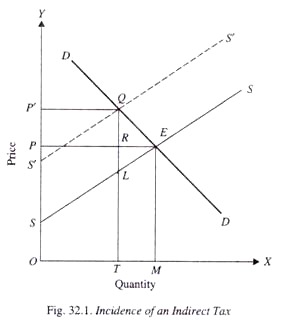
DD is the demand curve for a commodity and SS is its supply curve before the imposition of tax on it. Interaction of these demand and supply curves determines price OP of the commodity and OM is the quantity sold and purchased.
Suppose a unit sales tax, that is, sales tax per unit of the commodity equal to SS’ or LQ is levied by the Government on the commodity in question. This will raise the supply price of the commodity by the sellers as the unit tax SS’ will now be included by the sellers in their supply price.
As a result, the supply curve of the commodity will shift to the left by the magnitude of the tax SS’. The new supply curve S’S’ intersects the demand curve DD at the point Q and determines the new price OP’ and quantity exchanged OT.
It will be seen from Fig. 32.1 that price for the buyers have risen by PP’ or RQ whereas the tax per unit is SS’ or LQ which the buyers will bear. It may be noted that the buyers will bear the burden of a tax to the extent that they have to pay the higher price than before.
Thus the incidence of the tax borne by the buyers will be equal to RQ. The remaining part of the tax RL will be borne by the sellers. Thus, of the tax SS’ or LQ per unit, RQ is incidence of the tax on the buyers and RL is the incidence on the sellers. Now, we can show that the incidence of the tax RL and RQ on the sellers and buyers respectively is equal to the ratio of the elasticity of demand and the elasticity of supply.
RL/RQ = Incidence of tax on the sellers/ Incidence of tax on the buyers
Since RL is the incidence of the tax on the sellers and RQ is the incidence of tax on the buyers, we find that
RL/RQ = Incidence on sellers/ Incidence on buyers
= Price elasticity of demand/ Price elasticity of supply …(iii)
To conclude, to what extent the burden of the tax will be shifted and the proportion in which the buyers will share the incidence of a commodity tax depends on the elasticities of demand and supply.
What exactly incidence of tax on buyers RQ and incidence of tax on sellers RL will be equal to is given below:
ed/es = RL/RQ = Incidence of tax on sellers/ Incidence of tax on buyers …(iv)
If elasticity of demand for a commodity is zero, then from (iv) it follows that the incidence of tax on the sellers RL will be zero and from (iv) above it follows that incidence of tax RQ on buyers will be equal to whole tax t per unit. On the other hand, if the elasticity of supply is zero, then it follows from (iv) above that the incidence of tax on sellers RL will be equal to the whole amount of the tax t and as a result the incidence of tax 011 the buyers in this case will be zero in this case.
If elasticity of demand is infinity (ed. = ∞) then it also follows from above that RL = t, that is, the whole burden of the tax will fall on the sellers. On the other hand, if elasticity of supply is infinity, then it follows from above that RQ – t, that is, the whole burden of the tax will fall on the buyers. Let us graphically explain these cases of incidents of tax.
Incidence of Indirect Taxation and Elasticity of Demand:
If demand for a commodity on which a unit tax has been imposed is elastic, then as a result of the rise in price caused by the imposition of a tax, the people will buy substitute goods and the quantity demanded of the good will fall greatly.
In such a case, the incidence of the tax on the buyers will be relatively less. This is illustrated in Fig. 32.2. Take first, the demand curve DD which is relatively more elastic as compared with the demand curve D’D’ (dotted). SS is the supply curve which with the intersection of demand curve DD determines the price OP and quantity exchanged OM.
With the imposition of a unit tax, the supply curve shifts to the left and intersects the demand curve DD at point Q determining new price OP’ and the equilibrium amount ON. The distance between the two supply curves measures the tax per unit which is equal to LQ.
It will be seen from the figure that with the demand curve DD price has risen by PP’ or RQ. The remaining tax LR will be borne by the sellers. It will be seen that in this case of elastic demand the incidence of the tax RQ fallen on the buyers is smaller than that on the sellers RL.
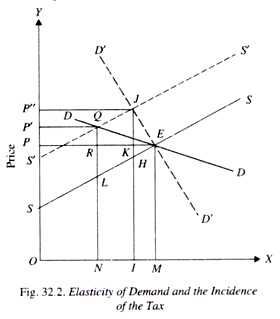
Now take the case of less elastic demand curve D’D’ (dotted). It will be seen from the Fig. 32.2 that the supply curve S’S’ obtained after the imposition of the tax per unit intersects the less demand curve D’D’ at point J. In this case of less elastic demand curve, price has risen by a greater magnitude PP” or KJ which will be the incidence on the buyers, whereas the sellers will receive HK less than before the imposition of tax. It will be thus noticed that in this case of less elastic demand curve, the incidence of the tax on the buyers (KJ) is much greater than the incidence on the sellers (HK).
It follows from above, the less the elasticity of demand, the greater the incidence of tax on the buyers, and in the extreme case when the elasticity of demand is zero, the whole tax will be passed on to buyers. On the other extreme, when demand for a commodity is perfectly elastic, the whole tax will be borne by the sellers of the commodity.
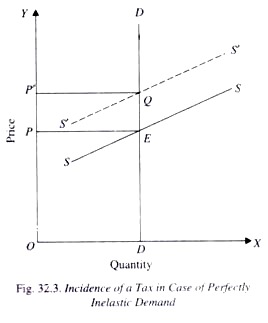
These are illustrated in Figs. 32.3 and 32.4. Take Fig. 32.3 which illustrates the case where demand curve is completely inelastic (i.e., e
d = 0) as actually happens in the case of necessities which cannot be substituted by some other goods and therefore their demand for them do not decline following the rise in the price after the imposition of a tax on them. It will be observed from Fig. 32.3 that in this case of completely inelastic demand price rises by the full amount of the tax when tax on the commodity is levied resulting in shift in the supply curve from SS to S’S’. Thus, in case of perfectly inelastic demand the whole incidence of tax rests on the buyers.
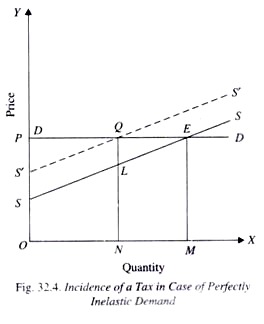
Figure 32.4 illustrates the other extreme case of perfectly elastic demand curve for a commodity. In this case price for the buyers remains the same following the imposition of tax and shifting of the supply curve from SS to S’S’. Thus in this case of perfectly elastic demand, tax burden on the buyers will be nil. As will be seen from Fig. 32.4, the quantity demanded falls from OM to ON and the price received by the sellers falls by the full amount of the tax QL. Thus, in case of perfectly elastic demand, the whole burden of the tax rests on the sellers.
Elasticity of Supply and Incidence of a Tax:
The division of the tax burden between the buyers and sellers also depends on the elasticity of supply. Given the demand conditions, the greater the elasticity of supply, the greater the incidence of tax resting on the buyers (consumers) of a commodity. Figure 32.5 represents the case of a commodity with a relatively elastic supply.
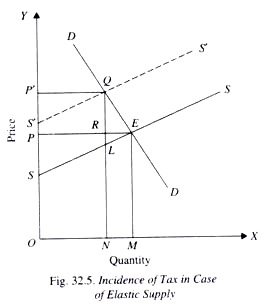
When the tax is levied on this commodity and supply curve shifts from SS to S’S’, the price rises from OP to OP’. The price increase is equal to PP” or RQ which will be the incidence of the tax on the buyers. Price received by the sellers is lower by RL and this will be the burden of the taxation on the sellers. It will be noticed that in this case of elastic supply curve, the incidence of tax on the buyers is greater than that on the sellers.
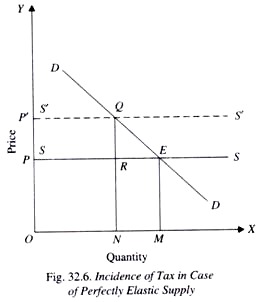
Figure 32.6 shows the incidence of tax in case of commodity with a perfectly elastic supply. It will be seen from this that as a result of the imposition of tax on this commodity and shifting of the supply curve, price rises by the full amount of the tax. Thus, in case of perfectly elastic supply the buyers have to bear the whole burden of the tax.
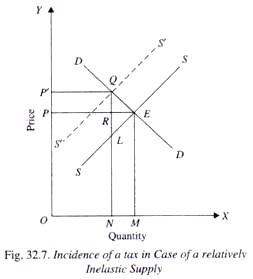
Figure 32.7 represents the incidence of tax in case of commodity with a relatively inelastic supply. It will be observed that the incidence of a tax on this commodity will be less on the buyers (RQ) than on the sellers (RL).
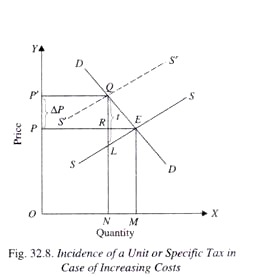 Incidence of an Indirect Tax and Cost Conditions of the Industry:
Incidence of an Indirect Tax and Cost Conditions of the Industry:
As mentioned above, cost conditions of the industry also determine the incidence of tax on buyers and sellers.
From the viewpoint of cost, industries can be divided into three categories:
(1) Increasing Cost Industries,
(2) Constant Cost Industry,
(3) Decreasing Cost Industry.
Following the imposition of a tax on a commodity, its price rises and, given the demand curve, at a higher equilibrium price less is demanded and produced. If a commodity is being produced under increasing cost conditions, then at a lower level of output cost per unit of output will fall. And due to this reduction in cost per unit as a result of imposition of a tax on that commodity, the price of the commodity will rise by less than the amount of the unit tax levied.
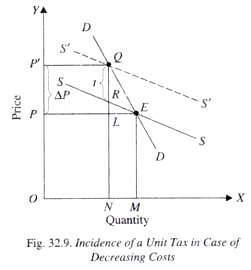
Thus, in this case which is illustrated in Fig. 32.8 the burden of the tax on the buyers will be less than the amount of the unit tax. On the contrary, when a commodity is being produced by an industry subject to decreasing costs, the decline in demand and output as a result of the imposition of a unit tax and rise in its price will cause cost per unit to rise.
In this case, as shall be seen from the Fig. 32.9, the price will rise more than unit tax on account of (1) imposition of tax on the commodity, and (2) rise in unit cost at a lower level of output. It will be observed from Fig. 32.9, while tax imposed on the commodity equals RQ, the price has risen by LQ or PP’ which is greater than RQ.
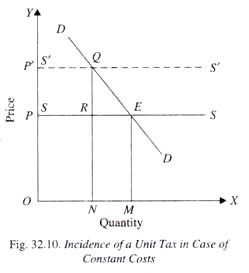
When the production of a commodity in an industry is subject to constant costs, then decline in output following the imposition of a unit tax and rise in price does not cause change in unit cost of production. In this case, as shall be seen from the Fig. 32.10 the price of a commodity rises by the same amount as the unit tax levied on it. Therefore, the whole burden of the tax will rest on the buyers.
Conclusion:
From our above analysis of the impact of cost conditions or physical returns to scale on the incidence of a commodity tax on the buyers and sellers we arrive at the following conclusions:
1. The incidence of a unit tax on the buyers will be less than the amount of the tax when the commodity is being produced under increasing cost conditions.
2. The incidence of tax on the buyers will be greater than the tax when the commodity is being produced under decreasing cost conditions.
3. The incidence of tax on the buyers will be equal to the amount of the tax when the production of the commodity is subject to constant costs.





